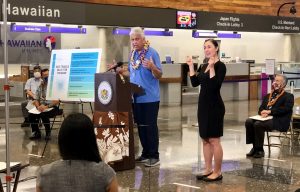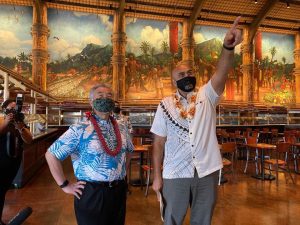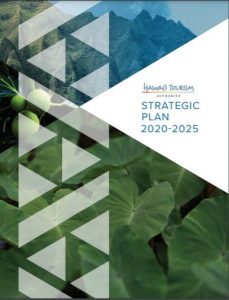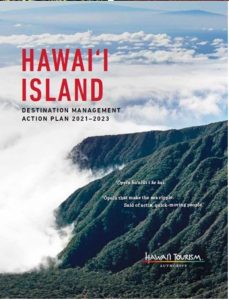HTA, communities work to redefine Hawai‘i 2.0 tourism
Posted on Apr 26, 2021 in Capitol Connection, Featured, MainRebuild. Redefine. Reset. Spend some time with John De Fries, new Hawai‘i Tourism Authority CEO, and it’s clear those are more than just words to him. “They reflect the shift in HTA’s 2020-2025 Strategic Plan that puts more emphasis on addressing tourism’s impacts in a sustainable way,” he explains. De Fries is well aware that a surge of visitors seeking a safe destination like Hawai‘i post-COVID could lead to an increase in negative resident sentiment and attitudes toward visitors. How to educate and manage the new wave of travelers tied to the state’s largest industry with more than 216,000 employees and $2 billion in state tax revenue—that’s the challenge facing HTA and local communities in the months and years ahead.
The solutions aren’t easy and they’re unique to each island, but for the past 14 months, steering committees statewide have created Destination Management Action Plans (DMAPs) based on community input that reflect this major shift in HTA’s approach. They include island-specific actions to be taken in the next three years and “hotspots” that residents are most concerned about. The result is a set of plans for more responsible, “regenerative tourism,” where the watchword is mālama — to care for and protect our islands. That’s why De Fries, HTA and Mike McCartney, director of the Department of Business, Economic Development and Tourism want to take a more comprehensive, mindful approach. That includes the Strategic Plan’s interacting “four pillars” of natural resources, Hawaiian culture, community involvement and marketing for responsible travel that can be managed in partnership with other state, county and community stakeholders. “We have an obligation to mālama the visitor, but at the same time, we need to educate the visitor on how to mālama us as a place, a people and as a society,” said De Fries. McCartney adds, “We’re at a pivot point where we can redefine tourism for a Hawai‘i 2.0 future.”
De Fries calls himself a keiki o ka ‘āina — a “child of the land,” who grew up in Waikīkī and fished its waters with his uncle. As a 40-year veteran of the visitor industry, he’s determined to find ways that tourism and the local community can not only co-exist but also provide a win-win solution. “I don’t see how you arrive at a model that’s sustainable unless the community owns it,” he adds. He also is the first Native Hawaiian to hold the position, which he says gives him an increased sense of accountability. “A close Hawaiian friend of mine said to me, ‘Our children need to see you succeed,’ says De Fries, who lives in Kona. “When he said that, the magnitude of it really hit me.”
De Fries became CEO at HTA on Sept. 16, just before Governor Ige launched the Safe Travels program with COVID-19 pre-travel testing. Since then, he has joined the core group of state leaders helping the state navigate the pandemic. “What I value about the governor is that he’s a critical thinker and he’s highly principled. That’s what you want right now in that office,” says De Fries. “Now we’re seeing him shift into higher gear to revitalize the economy and bring back jobs, which business leaders are welcoming in every sector. The increased vaccinations, the Safe Travels program and our own residents’ precautions are all working. In the end, a safe and healthy community is a safe and healthy destination for tourism.” De Fries also sees the pandemic as a chance to redefine the role tourism plays in economic diversification. “When the juggernaut of tourism stopped, carpenters, plumbers, carpet layers, arts and culture, graphic arts, IT—it became clear how all these areas we don’t associate directly with tourism—along with the farmers, restaurants and hotels—lost business opportunities,” says De Fries. “The industry can provide both on-the-job training and small business growth as well as a place for full-time employment.”
As for tourism’s future in a Hawai‘i 2.0, De Fries says, “The visitor industry is going to be central to the state’s economy for a long time because people will always be attracted to Hawai‘i. We need to educate our visitors and make them part of the solution. We can lead the industry by building on a set of larger, sustainable goals that protect natural and cultural resources. The most responsible form of tourism is regenerative tourism where our economic future is coupled with our ability to keep our islands healthy and flourishing. Ultimately, I believe Hawai‘i will be recognized as a place of healing—for ourselves and for the world.”
HTA’s Mālama Hawai‘i initiative and Destination Management Action Plans (DMAP) 2021-2023
The Mālama Hawai‘i program with local hotels, industry partners and volunteer organizations inspires mindful travel among visitors, allowing them to give back to Hawai‘i through environmental and cultural projects. For a current list, go to https://www.gohawaii.com/malama.
The community-based DMAPs for the counties of Hawai‘i, Maui and Kaua‘i are available at https://www.hawaiitourismauthority.org/what-we-do/hta-programs/community-based-tourism/. The O‘ahu DMAP will be completed this summer.
Read more in the Read more in the May Capitol Connection newsletter.





